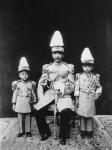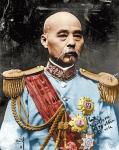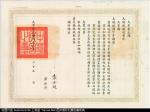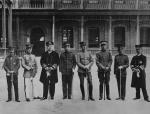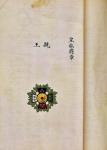-
Posts
851 -
Joined
-
Last visited
-
Days Won
3
Content Type
Profiles
Forums
Blogs
Gallery
Events
Store
Everything posted by drclaw
-
I've had a go at translating the original Decrees issued by Yuan Shikai. It's not a perfect translation so all suggestions would be very welcome. What's fascinating is the level of detail contained, including institutional arrangements such as procedures for recommending and awarding the Order, return of the insignia after death, forfeiture of the award where the recipient commits a crime, etc. The Decrees have come a long way compared to original decree establishing the Order of the Double Dragon. I believe it's the first time the statutes have been translated / published in English! -------- 陆海军勋章令 Decree on Orders for the Army and Navy 临时大总统公布陆海军勋章令令(1912年12月6日) 临时大总统令 兹制定陆海军奖章令公布之。此令。 中华民国元年十二月初六日 The Provisional President announces the Decree on Orders for the Army and Navy (6 December 1912) Provisional Presidential Decree The Decree to establish the Decorations for the Army and Navy is hereby announced. This Decree. The first year of the Republic of China, 12th month, 6th day [6 December 1912] 国务总理 赵秉钧 陆军总长 段祺瑞 海军总长 刘冠雄 教令 第九号 Prime Minister Zhao Bingjun Chief of the Army Duan Qirui Chief of the Navy Liu Guanxiong Decree Number 9 陆海军勋章令 第一章 总则 Decree on Decorations for the Army and Navy Chapter 1: General Provisions 第一条 陆海军各种勋章,凡民国陆海军人于平时战时著有勋劳,或非陆海军人及外国人于陆海军特别任务中著有勋劳者,皆得分别给与 Article 1: These medals are awarded to members of the Republican Army and Navy for meritorious service in times of peace or war, and to foreigners in the Army and Navy for meritorious service. 第二条 陆海军勋章分二种: • 一、白鹰勋章 • 二、文虎勋章 Article 2: There are two decorations for the Army and Navy: 1) The Order of the White Eagle; 2) The Order of the Striped Tiger 第三条 各种勋章均分九等。一、二等给与上等官佐;三等至六等给与、初等官佐及准尉见习军官;七、八、九等给与士兵。 Article 3: The decorations are divided into nine classes. The First and Second Class is for senior commissioned officers. The Third to Sixth Class is for junior commissioned officers, warrant officers and trainee officers. The Seventh to Ninth Class is for soldiers. 第四条 给与勋章时,均附给执照,载明勋绩。其应给年金者,即以其执照为领金之证据。 Article 4: Medals are to be accompanied by a licence document that specifies the recipient’s meritorious actions. An annuity will be granted with the licence document to be presented as evidence for payment. 第二章 白鹰勋章 Chapter 2: Order of the White Eagle 第五条 白鹰勋章中心镂刻白鹰。 Article 5: The centre of the White Eagle medal should feature a White Eagle. 第六条 依陆海军叙勋条例,有殊勋者给与白鹰勋章。 Article 6: Individuals who perform exceptional merits as defined by the Army and Navy Regulations may be awarded the Order of the White Eagle. 第七条 凡受有白鹰勋章者,按其等级,得依陆海军勋章年金法受一定之年金。 Article 7: All recipients of the Order of the White Eagle may receive an annuity for the class of award as determined by the Annuity Regulations. 第三章 文虎勋章 Chapter 3: Order of the Striped Tiger 第八条 文虎勋章中心镂刻文虎。 Article 8: The centre of the striped Tiger medal should feature a Striped Tiger. 第九条 依陆海军叙勋条例,有武功或劳绩者给与文虎勋章。 Article 9: Individuals who perform military contributions and merits as defined by the Army and Navy Regulations may be awarded the Order of the Striped Tiger. 第四章 佩带规则 Chapter 4: Rules for Wearing 第十条 一、二、三等白鹰勋章佩上衣第一纽上;一、二等文虎勋章佩左胸部大绶上方、普通章下方,三等文虎勋章佩上衣第一纽上。各种一、二等勋章有大绶一条,一等红色,二等黄色,佩于左肩至右胁下;四等至九等勋章,均用小绶,佩于上衣左襟之上;四等至六等绶用绿色,七等至九等绶用蓝色。 Article 10: The First, Second and Third Class White Eagle should be worn over the top button of the jacket. The First and Second Class Striped Tiger star should be worn on the top left breast, above other medals. The Third Class Striped Tiger should be worn on the jacket on the first button. The sash for the First Class Striped Tiger is red while that for the Second Class is yellow. The sashes are worn over the left shoulder stretching to the right side. The Fourth to Ninth Class are worn on a small ribbon on the left jacket near the lapel. The ribbon for the Fourth to Sixth Class is green. The ribbon for the Seventh to Ninth Class is blue. 第十一条 各种勋章于著军礼服、军常服时,均可佩带。但著常服佩带、二等勋章时,不佩大绶。 Article 11: The medals may be worn with military uniform. When a First or Second Class award is worn with military uniform, the sash must not be worn. 第十二条 已受一种勋章而更受同种上级之勋章者,其下级勋章缴部核。若受他种勋章,无论是否同级,均得并佩。 Article 12: Where an individual who already has an award receives a higher award of the same Order, the lower class insignia must be returned to the Ministry regardless of whether it has been worn. 第十三条 受有两种以上之一、二等勋章者,只佩较高级之大绶。 Article 13: Where an individual has the First and Second Class of two Orders, only the Grand Cordon of the superior Order is worn. 第十四条 并佩两个以上之勋章时,以等级较高者列于较次者之右方。如一行不能并列,亦得列为两行。 Article 14: Where two or more medals are worn, they are worn on a single line with the highest on the right. If medals cannot be worn on a single line, they may be worn on two lines. 第十五条 佩带本国普通勋章时,按普通勋章佩带规则施行,普通勋章与陆海军勋章同时佩带,普通勋章列于陆海军勋章左方。 Article 15: When ordinary national medals are worn together with the Army and Navy Orders, the ordinary medals are worn on the left side. 第十六条 受有外国勋章者佩带时,应将本国勋章列外国勋章之右方。 Article 16: Where foreign medals are worn, these are worn on the right hand side. 附勋章执照式: Award licence document: 陆海军勋章执照 大总统为给与 等勋章,用示奖励,特给执照,以资证明。 陆 军总长 海中华民国 年 月 日 第 号 “Army and Navy Order Licence The President awards; the name and class of the Order; the reasons for the award / in recognition of, the reasons for the award; recipient’s details. In witness whereof. Name of the Chief of the Army or the Chief of the Navy Republic of China Year … Month … Day Number ----- 修正陆海军勋章令第三条 临时大总统公布修正陆海军勋章令第三条令(1913年4月9日) 临时大总统令 兹修正陆海军勋章令第三条公布之。此令。 中华民国二年四月初九日 国务总理 赵秉钧 陆军总长 段祺瑞 海军总长 刘冠雄 教令 第二十六号 Decree to Amend to Article 3 of the Army and Navy Decree The Provisional President hereby announces amended regulations to the Army and Navy Medal Decree on 9 April 1913. Provisional Presidential Decree Article 3 of the Army and Navy Decree is hereby amended. This Decree. Republic of China 9 April 1913 Prime Minister Zhao Bingjun Army chief Duan Qirui Navy chief Liu Guanxiong Decree Number 26 修正陆海军勋章令第三条 第三条 各种勋章均分九等,一、二、三、四等,可给与上等官佐,三、四、五、六等可给与中等官佐,四、五、六、七等可给与初等官佐及准尉、见习军官,六、七、八、九等可给与士兵。但叙给各等官兵勋章应按助功劳绩,分别核议,不得于各官等间以官级分别勋等 Article 3: The Orders are divided into nine classes. The First to Fourth Class may be awarded to senior commissioned officers. The Third to Sixth Class may be awarded middle ranking commissioned officers. The Fourth to Seventh Class may be awarded to junior commissioned officers, warrant officers and trainee officers. The Sixth to Ninth Class may be awarded to soldiers. This change in classification should encourage meritorious performance by soldiers by linking it more to their individual merits as opposed to their official rank in government. ----- 陆海军叙勋条例 临时大总统公布陆海军叙勋条例令(1912年12月6日)临时大总统 兹制定陆海军叙勋条例公布之。此令。 中华民国元年十二月初六日 国务总理 赵秉钧 陆军总长 段祺瑞 海军总长 刘冠雄 教令 第十一号 Decree on Army and Navy Merit Categories On 6 December 1912, the Provisional President announced Regulations for Army and Navy Merit Categories. Provisional President The Regulations for Army and Navy Merit Categories are hereby announced. This Decree. 6 December 1912 Prime Minister Zhao Bingjun Army chief Duan Navy chief Liu Guanxiong Decree Number 11 陆海军叙勋条例 Decree on Army and Navy Merit Categories 第一条 叙勋分二种: • 一、殊勋; • 二、武功及劳绩。 Article 1: There are two categories of merits: (1) exceptional merits; (2) military contributions and merits 第二条 在战时立有左列勋绩者,谓之殊勋: Article 2: Exceptional merits are those performed during war for any of the following: 一、夺获敌军重要地点者; (1) The capture of key locations from the enemy 二、夺获敌军军旗、大炮及重要军械者; (2) The capture of the enemy’s flag, cannons or important arms 三、断绝敌军交通或截获敌军粮饷、军械,战局因以奏功者; (3) Cutting off enemy transportation or intercepting enemy supplies or ordinance, for contribution to wartime success 四、运筹适宜,致获全功者; (4) Successful logistical operations 五、在战斗间处置善良,确与全军或一部有重要之关系者; (5) Conduct in combat making an important contribution to the army 六、冒险前进,侦得敌人重要军情,致获全功者; (6) Risky forward reconnaissance to determine important enemy situation thereby contributing to military success 七、于最困苦缺乏时,毅然从事战斗,足振起他人之志气者; (7) Remaining resolute in desperate combat situations and by example raising others’ morale 八、歼殪或捕获敌军重要将校者; (8) Killing or capturing an important high ranking enemy officer 九、捕获或轰沉敌之军舰者; (9) Capturing or sinking enemy warships 十、冒险破坏敌人伏置水雷或障碍物,得以开导我军舰之进路者; (10) Taking risks to destroy mines or other obstacles to enable passage of friendly warships 十一、我炮台被敌军包围,我港湾被其封锁,以苦战辟运输之途,终得达其目的者; (11) Successfully delivering supplies to a beleaguered fortress or a blockaded sea port 十二、我军舰被敌之优势舰队攻击,他无应援,终得免敌之捕夺,保全名誉脱归者; (12) Avoiding capture and preserving honour when faced with superior enemy ships and without friendly assistance 十三、我军舰护送多数船舶与敌之优势舰队相遇,剧战之后所护送船舶得以安全航到其目的地者; (13) When encountering a superior enemy fleet when escorting friendly ships, succeeds in safely protecting the friendly ships to reach their destination. 十四、占领敌之炮台、港湾或有守备之城市者; (14) Capturing of an enemy fort, harbor or garrisoned city. 十五、夺还敌军拥护我被掠之军舰者; (15) Capturing supplies from an enemy warship 十六、闯入敌之港湾内捕获或破坏其舰船者; (16) Entering an enemy harbor to capture or destroy enemy ships 十七、冒险伏置水雷,得以轰沉敌之军舰,或加危害使之失其战斗力者 (16) Risky setting of sea mines to sink enemy warships or to cause damage that result in a loss of combat effectiveness 十八、冒险封锁敌之港湾,得尽其任务者; (17) Risky blockade of an enemy harbor to complete a mission 十九、战斗中我舰受大损伤,挺身冒险施应急处置,得以保全其舰之运命者。 (18) When a ship has experienced serious damage in battle, participating in risky emergency actions to preserve the ship. 第三条 在战时或平时立有左列功绩者,谓之武功或劳绩: Article 3: Military contributions or merits are any of the following in times of war or peace: 一、救护长官之危急以立功者; Rescuing of a senior officer thereby rendering meritorious service 二、力疾或负伤,而强与战斗者; Continuing to fight strongly despite wounds or illness 三、冒险前进,达到命令中指定之任务者; Engaging in risky advances to complete a mission 四、战斗间勇敢率先,夺取枪械及捕获敌人者; Showing leadership in combat to capture enemy weapons or soldiers 五、捕获或轰沉敌之军用船舶及其商船者; Capturing or sinking enemy warships or merchant vessels 六、战时办理战线以后事务,成绩最著者; Commendable management of affairs after wartime 七、平定内乱,功绩卓著者; Outstanding accomplishments in suppressing rebellion 八、旅行于交通未备区城,作有报告图表,足资军事之助者; Planning and accomplishing the delivery of vital military supplies 九、本舰航海停泊中或他舰航海停泊中遇有危急,冒险从事救护,得以免其危险者; Giving risky assistance or rescue to ships in distress 十、冒险救助被难船舶,得以救护其生命财产者; Taking risks to salvage life or property on ships in distress 十一、发明陆海军学理及军用物品,有益于军事前途者。但以陆海军部查核认可为限; Developing new research or inventions for future military combat as recognized by the Ministry of the Army and Navy 十二、在边远瘴疠地方戍守国境或从事屯垦满二年以上,克尽厥职者; Showing dedication by guarding remote locations for at least two years while being exposed to malaria and other tropical diseases 十三、镇压内乱,擒获匪首,剿除匪党者; Suppressing civil unrest, bandit activity or capturing bandit leaders 十四、识破或捕获国际奸细,证据确凿者; Detecting or capturing foreign spies 十五、镇压内乱时,夺取匪寨,收复被据城池者; Capturing a bandit stronghold or rebel city when suppressing civil unrest 十六、捕获海贼或国际海贼,证据确凿者。 Capturing or suppressing pirates 第四条 陆海军各种勋章,除大总统当然佩带外,得由大总统特赠外国大总统暨皇帝君主。 Article 4: In addition to wearing the Army and Navy Orders, the President may present them to a foreign President or foreign monarch. 第五条 各种勋章,除由大总统特令颁给外,所有立功人员,均由该管长官按本章调查表查实详记,并将该员履历功绩事实具报陆海军总长,由陆海军总长呈请大总统批准遵行。 Article 5: Except where specially conferred by the President, for individuals performing meritorious service as specified by these Regulations, a full report and personal history of meritorious deeds must be prepared by the Army and Navy and presented to the President for authorization for award. 第六条 战时立功人员应给勋章者,无论在战役之中或战役之后,均可呈报陆海军总长核办。 Article 6: During wartime, recommendations for awards for meritorious service should be made during or after the battle in the campaign to the Army and Navy Command. 第七条 平时著有功勋劳绩人员,应于每年二月内由各省处长官报部,于四月内由该管总长转呈大总统批示遵行。 Article 7: Usually, individuals who have performed meritorious service should be reported by senior provincial officials to the Ministry in February each year. These recommendations should then be considered by the President by April. 第八条 颁给勋章经大总统特令或批准后,由陆海军部注册,并将执照附同勋章颁由该省最高级陆海军长官传集所部列队授与;如系给与士兵,则仅传集该连授与。 Article 8: When an award has been made by the President by special order or approval, the award is registered by the Ministry of the Army and Navy. The medal and accompanying licence document is then distributed to the province’s most senior army and navy commander to confer to his subordinates. Awards to soldiers can be conferred by his subordinate officers. 第九条 战时之陆海军总司令官,得依战役景况,先行给与部下三等以下勋章,事后报部查核。 Article 9: During wartime, the commander of the Army or Navy may, depending on the campaign situation, award the Third Class and below. Afterwards, a report must be made to the Ministry for confirmation. 第十条 所受勋章附有年金者,自颁到勋章之日起算。 Article 10: When an annuity is granted with an award, the date of annuity commences from the date of the award. 第十一条 叙勋时与立功时官职阶级不同者,仍以立功时官职论赏。 Article 11: When after receiving an award for meritorious conduct, there is a difference in classification between the meritorious award and the recipient’s government or official rank, the meritorious award is still retained. 第十二条 受有勋章而更立功绩者,可换给原章之高一级者或加给他种勋章。但受有两个同种之勋章时,应将其较次者及执照一并呈缴陆海军部核销。 Article 12: When a holder of an award performs meritorious deeds entitling him to a higher class, he can exchange his existing class for the higher class. Where however he receives two awards of the same class and Order, one must be returned together with its licence to the Army and Navy Ministry for cancellation. 第十三条 叙勋公文呈报之际,或已呈而未奉部覆时,该员如有休职、退役、转免、死亡等情,应按其事实迅速报部,以凭核办。 Article 13: Where there has been a change in the circumstances of the recipient such as retirement from official position or death, this must be notified to the Army and Navy Ministry records department. 第十四条 应受勋章年金者,于休职或退役时,由该省陆海军长官报部注册,并移知原籍地方官署或住在地方官署立案,即由该地方官署按执照发给年金。 Article 14: When a recipient receiving an annuity retires from office or changes his residence for example to return to his ancestral village, the change must be notified and recorded on the licence document for payment of the annuity. 第十五条 受褫夺公权之宣告者,即褫夺其勋章。 Article 15: Where a recipient is declared by attainder to have been stripped of political rights, the award is to be forfeited. 第十六条 因污辱军人名誉而受免官处分或重于免官处分者,即褫夺其勋章。 Article 16: Where a recipient engages in conduct unbecoming to a serviceman or is dismissed from the army or navy as punishment, the medal is to be forfeited. 第十七条 处刑法徒刑以上之刑未受褫夺公权之宣告者,得停止其佩带勋章。 Article 17: Where a recipient has been found guilty of a crime and sentenced to imprisonment, the award is to be forfeited. 第十八条 受有勋章者,如身故或当褫夺时,应将勋章并执照呈送本军队处所或地方官署转缴陆海军部注销。 Article 18: The medal and licence document must be returned to the Army and Navy Ministry upon the death of the recipient or forfeiture of the award. 第十九条 应受勋章年金之人身故,匿不呈报而继续领取者,按法治罪。 Article 19: A person who conceals the death of a recipient and continues to collect the annuity is guilty of a crime. 第二十条 如未经领受勋章,私造佩带或佩带他人所受之勋章者,按治治罪。 Article 20: Where a person who is not a recipient of the award wears or counterfeits it, the person is guilty of a crime. 第二十一条 如有将勋章卖让、典质及抵偿货财、债务等事,查明将勋章注销。 Article 21: Where a medal has been pawned or sold, the award is forfeited. 第二十二条 勋章及执照如有遗失,准其补给。但于勋章背面附以补给记号,执照之内注明补给字样。其原件如有查获者,应即送部注销。 Article 22: Where a medal or licence is lost, the Army and Navy Ministry must be notified to ensure cancellation of the licence document.
-
Congratulations and thanks for sharing! Your patience and persistence certainly paid off and it is great to see a complete set. It's like assembling a vintage Spitfire from different parts. The end result is just beautiful.
-
It doesn't show his Grand Order but this younger photo of Zhang Zuolin, the Mukden Tiger, is priceless. Here the Old Marshall is with two of his sons, all wearing egret plume kepis! Zhang Xueliang (the Young Marshall) is standing on the right. Both boys are already festooned with decorations. After the assassination of his father by the Japanese, Zhang Xueliang overcame his opium addiction and proclaimed for the Guomindang government. In the 1936 Xian Incident, he kidnapped Chiang Kai-shek to force him to agree to a united front with Mao's Communists against the Japanese invaders. He was arrested by Chiang at the earliest opportunity and spent the next 50 years in house arrest.
-
At last, not a photo of Cao Kun but his 1923 silver dollar coin. It shows him in civilian attire wearing only the Grand Order.
-
Feng Guozhang with the Grand Order. That's five recipients we have photographic evidence for so far: Yuan Shikai, Li Yuanhong, Feng Guozhang and Xu Shichang (the first four Presidents of the Republic) and Premier Duan Qirui Sun Yat-sen declined the award, which leaves the Taisho Emperor of Japan, Cao Kun and Zhang Zuolin. Interestingly, the large official portrait photo of Cao Kun which has him wearing the White Eagle does NOT have him wearing the Grand Order. That photo was most likely taken when he was President as to my knowledge he is the only recipient of the White Eagle - an Order that could only be awarded for "extraordinary merits in war" but which the President was entitled to wear. While China declared war on the Central Powers in WW1, China's contribution were the 140,000 labourers of the Chinese Labour Force. No Chinese soldier actually fought. And no Beiyang government would have impliedly recognised any of its regional rivals in the many warlord conflicts by conferring the White Eagle.
-
I stand corrected on this one. According to Chinese references, there is no record of Puyi having received the Republican Grand Order. This original photo is dated 1934 (although he appears younger here). It is most likely that he is wearing the Imperial Grand Order. Besides, why would he be wearing the decoration of the Republic that evicted him from the Forbidden City and repudiated the Articles of Favourable Treatment, and which in any event was abolished by the new Nationalist Government in 1929? Puyi was made Emperor of Manchukuo on 1 March 1934 and the Orders of Manchukuo established on 19 April.
-
A better photo. Clearly visible are the two pearls on each of the four arms of the badge + the centre pearl. 9 pearls in total = Second Class, giving him the rank of Marquis or Hou. Wellington Koo (1887-1985) was China’s most respected statesman. Educated at Columbia University, Koo served in the League of Nations, the United Nations and the International Court of Justice. He is also wearing the Precious Brilliant Golden Grain and the Golden Grain, both in the First Class. His blue diplomatic court uniform is embroidered with the golden wheat motif of the Republic.
-
Here is a photo of Wellington Koo, China's most famous diplomat of the 20th century, wearing the Order of Rank and Merit. This gorgeous document MIGHT be his award document bearing Presidential seal and signature of Yuan Shikai, dated 25 July 1915. Others with better Mandarin may be able to confirm. Source: www.huisongshu.com http://gmic.co.uk/uploads/monthly_05_2013/post-11630-0-71499500-1368841962.jpghttp://gmic.co.uk/uploads/monthly_05_2013/post-11630-0-74284200-1368842015.jpg
-
Like the other orders of the Early Republic / Warlord Period, the Order of Rank and Merit was abolished in 1929 by the new Guomindang government in Nanjing. However, awards likely ceased in 1928 following the defeat of the Beiyang warlord government by Chiang Kai-shek in the Northern Expedition. Most contemporary warlord photographs depict them wearing the Order of Rank and Merit and it appears the award was fairly widely distributed, at least to senior military officers. However, very few examples have appeared on the international market or in China. The most recent specimens I'm aware of were a Grand Class in the 2008 UBS Tammann Collection auction and a Third Class in the 2007 Morton & Eden American Numismatics Society Collection auction. Given the rarity and price of original insignia, reproductions are now being encountered in the Chinese market.
-
Both the peony flower and tung leaf designs of the Imperial Nobility Badge were adopted. The designs were however reversed. The Grand, First and Second Class badge featured peony flowers in the same style as the junior category of the Imperial Nobility Badge, while the Fifth and Sixth Class feature the tung leaves of the senior category. We can detect a personal preference by Yuan Shikai and his cronies for the more flamboyant peony flowers for the insignia their rank entitled them to, rather than the “plain” tung leaves. As for the introduction of ranks of nobility, etc, Yuan began reviving imperial rituals and led sacrifices at the Temple of Heaven that were traditionally performed by the Emperor. In November 1915, Yuan proclaimed himself Emperor with the reign name Hongxian (洪憲) or “Constitutional Abundance” - ironic in the extreme. Yuan's grasp for the Dragon Throne however ignited a firestorm and he was forced to repeatedly delay his accession before abandoning it altogether. He died in humiliation shortly after in June 1916 and his death ushered in the "High Warlord Period". Autengruber and Tammann report (2008 UBS Tammann Collection auction catalogue) that in 1916, the name of the Order was changed to the Order of Merit and titles of nobility no longer conferred with the award. I believe, the change was likely instituted by President Li Yuanhong following Yuan Shikai’s death. Li was an earnest and committed Republican who shared the dismay many felt about Yuan’s attempt to install himself Emperor. Ironically, Li would be deposed by a monarchist coup launched by the "Pigtail General" Zhang Xun. This restored the Qing Dynasty for five days before being crushed by Republican troops under the command of the "Christian Warlord" Feng Yuxiang.
-
Astoundingly for a Republic, the award was also accompanied by a title of nobility! In doing so, the Republic went beyond its obligation under Articles of Favorable Treatment (agreed with the Qing Court for the abdication of the Emperor) to maintain the privileges of the old nobility. It was now creating new members of nobility. The titles conferred were: · Grand Class: Prince – Qinwang (亲王, Prince of the First Rank), Junwang (郡王, Prince of the Second Rank), Beizi (贝子, or Prince of the Third Rank), Beile (贝勒, Prince of the Fourth Rank) or Qin (亲, blood relation); · First Class: Duke – Yi gong qin (乙公亲) or Gong; · Second Class: Marquis – Bing hou qin (丙 侯亲) or Hou; · Third Class: Count – Ding bo qin (丁伯亲) or Bo; · Fourth Class: Viscount – Wu zi qin (戊子亲) or Zi; and · Fifth Class: Baron – Yi nan qin (已男亲) or Nan
-
On 8 August 1912, the Republic again resurrected China’s Imperial past in its second highest honor – the Order of Rank and Merit (Xun Wei Zhang, 勋位章, “Merit Rank Badge”). The statutes for the Order comprise regulations issued on 8 August 1912 and 13 January 1913. Most references cite 13 January 1913 as the founding date of the Order. Certainly most of the institutional and practical arrangements for the award, such as the design of the insignia, are contained in the 1913 regulations. The Order was conferred in six classes for meritorious service to the Republic: · Grand Class (Da Xun Wei, 大勋位); · First Class (Xun Yi Wei, 勋一位); · Second Class (Xun Er Wei, 勋二位); · Third Class (Xun San Wei, 勋三位); · Fourth Class (Xun Si Wei, 勋四位); and · Fifth Class (Xun Wu Wei, 勋五位) The insignia was virtually identical to the earlier Imperial Nobility Badge with some minor but symbolic differences. The color of the center medallion was changed from yellow (representing the Emperor) to red (representing the majority Han Chinese). The badge was gilded silver and all the stones pearls. The classes were differentiated by the total number of pearls including the center pearl stone: Grand Cordon (13 pearls), First Class (11 pearls), Second Class (9 pearls), Third Class (7 pearls), Fourth Class (5 pearls) and Fifth Class (3 pearls). The President could, with the Senate’s approval, grant the recipient a lifetime annuity. This was an extraordinary privilege and the Order of Rank and Merit and the military Order of the White Eagle were the only two orders to accord that privilege. For the Order of Rank and Merit, the annuities were: Grand Class (10,000 yuan), First Class (8,000 yuan), Second Class (6,000 yuan), Third Class (5,000 yuan), Fourth Class (4,000 yuan) and Fifth Class (3,000 yuan). Note: Only one award of the Order of the White Eagle is known – a Second Class Order that Cao Kun likely awarded himself when President. The Regulations for the White Eagle specified it could only be awarded for extraordinary merits in time of war although the President was automatically entitled to wear the award. While China declared war on the Central Powers in the First World War, her contribution was the 140,000 laborers of the Chinese Labor Force.
-
One of President Yuan's early acts was to establish a new system of national honours. On 29 July 1912, President Yuan instituted the Republic's first two orders: the Grand Merit Order (Da Xun Zhang, 大勋章, also known as the “Grand Order”), the Republic’s highest decoration, and the Order of the Golden Grain (Jia He Xun Zhang, 嘉禾勋章, or just Jia He Zhang). The Grand Merit Order was intended only for Presidents of the Republic and foreign heads of state. The insignia was virtually identical to the Imperial Grand Precious Order (Da Bao Zhang, 大宝章, also known as the “Grand Order of the Throne”) founded by Emperor Puyi in the final year of the Qing Dynasty. The insignia featured the Twelve Symbols of Imperial Authority traditionally associated with the Emperor and which were embroidered on the Emperor’s dragon robes! http://gmic.co.uk/index.php/topic/54527-the-grand-order-its-origins-design-and-recipients/
-
Following the 1911 Revolution, China became a Republic in 1912 with former Qing strong-man Yuan Shikai as President. Imperial rule would however cast a long shadow over the new Republic. Many of the traditions and symbols of the Empire were adopted by the Republic. The five colours of the Nobility Badge would feature in the new national flag, with the colours now representing the five races: Han (red), Manchu (yellow), Tibetans (black), Mongols (blue), Hui or Muslims (white).
-
Manchu princes resign en-masse in 1911. Princes Zaixun (third left) and Zaitao (fifth left) were brothers of the regent Prince Chun and uncles of Emperor Puyi. Both received Ministerial posts in the reorganised Imperial Cabinet of April 1911 which included eight Manchu princes, one Mongol and just four Han to the fury of the Han Chinese that made up over 90 per cent of the population. Zaixun was appointed China’s first Minister of the Navy in December 1910 and is seen wearing the uniform of an admiral. Zaixun and Zaitao received the Order of the Double Dragon (First Class, Second Grade) in 1909 and four of the princes are wearing Double Dragon insignia. Four princes are also wearing the Imperial Nobility Badge introduced in 1909.
-
There were two categories of badges with sub-categories reflecting the complicated Qing peerage system. The badge featured a centre medallion with four arms. The colours of the arms were red, black, white and green, with the centre in yellow. These colours represented the Five Cardinal Points - north, south, east, west and the centre in yellow for the Emperor. The medallion depicted a cogon grass which was used to filter wine for sacrifices and ritual and was associated with granting noble titles and land. For the first category (Imperial family), the badge was transposed on a wreath of tung leaves. Tung leaves have a long tradition and were used by Emperor Cheng of the Zhou Dynasty (around 1000 BC) to "canonise" his brother. For the second category (general nobility as well as the hereditary nobility from the outer region feudatory states like Mongolia), the badge was transposed on a wreath of peony flowers. The Nobility Badge was NOT an order or decoration as we might understand those terms. It was issued as an emblem of existing noble rank to be worn with uniform, in the same way a policeman might wear a badge. Here is an illustration of the Qinwang (Prince of the First Rank) badge from the original Decree. Source: www.zgsd.net.
-
I've been doing some more research on this Order and wanted to share this and to expand Nick's excellent thread. First, the inspiration for the Order. Modernisation of the Chinese army began in the late 19th century and continued after the Boxer Rebellion. In 1908, an Imperial Guard Division was established with a new Westernised grey uniform. Similar uniforms in blue (Winter) and light khaki (Summer) were introduced for the Imperial Army in 1910. Prior to that, Chinese soldiers were dressed in baggy blue blouses, pants and turbans while some of the provincial and Banner armies wore even more archaic colourful uniforms - the type you see in old coloured prints of the Sino-Japanese War and the Boxer Rebellion. The Qing Dynasty had a complicated peerage system based on ancient Chinese tradition with added Manchu influences. Broadly, this fell into two categories: the Imperial Clan (Imperial princes, other members of the Imperial Clan who were direct male descendants of an Emperor, other family members); and the general nobility. To preserve their Manchu martial traditions and to maintain control over the country (the Manchus comprised less than 2%, ruling 400 million Han Chinese increasingly resentful of their "alien" rulers"), many members of the Imperial family and nobility served in the Imperial army. With the introduction of drab, Western-style uniforms, it was decided that some sort of insignia were needed to allow differentiation in the wearer's noble rank. On 12 February 1909, Zaitao, Prince of the Second Rank and Minister for Training the Imperial Guard, submitted a Memorial to the Xuantong Emperor. The Memorial proposed the introduction of Nobility Badges (Jue Zhang, 爵章) to be worn with formal uniform and sword. The Emperor (or rather the Regent) approved the Memorial on 9 April and decreed that the badges be issued to members of the imperial family and nobility on joining the army. The badge was to be worn with formal uniform and sword, on the lower left near the waist. Responsibility for manufacturing and distributing the badges was assigned to Zaitao as the Minister for Training the Imperial Guard.
-
I suspect most of the winning bids might be "friends". It will keep cycling through until someone else wins.
-
Unbelievable! If I'm not mistaken, a First Class St Stanislaus set would normally sell for upwards of $15,000 or thereabouts. But in Swords?! And the much, much rarer non-Christian version?!!
-
If you dangle a line long enough eventually you'll catch a fish ... I'm sure he has a First Class Golden Kite breast star and sash badge too!
-
Thanks for this info Glen. Interesting info about the rank restrictions on the wearing of neck grade orders. The Japanese were equally relaxed and enjoyed wearing their finery. In terms of the photographs I've seen of senior recipients wearing the Double Dragon, the Japanese would make up the largest group.
-
Wonderful stuff Nick. The black and white illustrations appear to have been taken from the original Double Dragon statutes.
-
I guess there will always be challenges from second and third translations from the original Chinese, especially with going back to old texts. The badges we've seen on this thread bear the Chinese characters "Gong Pai" or "Merit Badge" in English. Silver "Gong Pai" badges or "medals" were previously awarded to Qing soldiers especially after the Taiping Rebellion. So the medals here are a natural successor to these early decorations. So the medals here are Military Merit Medals, NOT "Commemorative Medals". The later Republic would institute a number of Commemorative Medals and this practice continued under the Nationalists, e.g. Presidential Inauguration Medals, World War 2 Victory Medal, etc.
-
Glenn, were there any restrictions on German recipients on the wearing of the Double Dragon? For example, the UK Regulations Respecting Foreign Orders (1855) prohibited British subjects from accepting or wearing a foreign order without prior approval by the British Government. Permission could be granted in only limited circumstances: where the recipient had performed “active and distinguished service before the enemy”; or where the recipient had been “actually and entirely employed, beyond Her Majesty’s dominions, in the service of the foreign sovereign by whom the Order is conferred”. Strict time limits applied and approval had to be sought within two years of the conclusion of peace, or from the date of employment or service. As such, British citizens could not receive permission to wear foreign Orders conferred as a gift or courtesy. Most of higher class Double Dragons - awarded to visiting British diplomats, statesmen, military officers, etc - would therefore fall in this category. So I wonder if other countries (e.g. Germany, France, Russia) were more relaxed with their citizens?
-
Not entirely convinced that the Oskar Nenninger specimen is silver as opposed to silver gild. The tarnish could also appear patinated gild. I'm even more convinced that the Morton and Eden example is gilded. I have Double Dragon with very similar patination which when cleaned / polished was gilded. Also see the suspension ring which presumably would have been "buffed" by the ribbon. This appears to be gild. We also have two documentary sources - Trost (1910) and the Stammliste des Marine-Sanitats-Offizierkops (1906) - referring to gold and silver medals. Guess the only way to confirm this would be to clean the medal.




